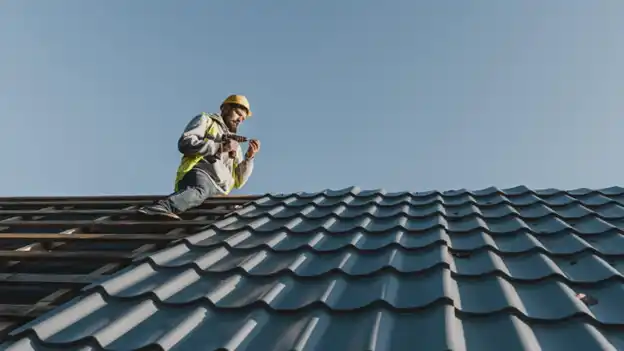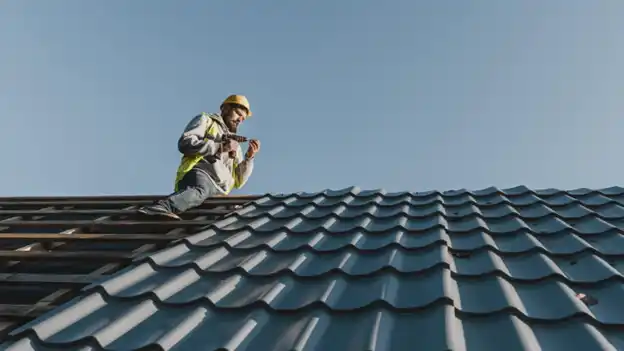

Most roofs are built with a slope, which helps rainwater flow easily off the building. Gutters gather the water and direct it away from the edges, helping protect the building’s walls and foundation from damage. But many commercial buildings have flat roofs. These roofs don’t let water drain naturally because they don’t have a slope.
Without a good drainage system, water can pool and stay on a flat roof for a long time. This standing water can cause serious problems. It can damage the roof’s surface, cause leaks, and weaken the roof’s structure. Because of this, having an effective drainage system on a flat roof is very important.
Luckily, there are several drainage options to choose from for flat commercial roofs. If you notice water standing on your roof, it’s best to contact a professional right away. Experts in roofing Maui can help install the right drainage system for your building.
Why Is Drainage Important for Flat Roofs?
Flat roofs are popular for commercial buildings because they are usually less expensive, last a long time, and can help save energy. In some cases, they can even be used as extra storage space. They’re simple to take care of and can be replaced without much trouble when necessary.
However, flat roofs do have some challenges:
- Water can collect and stay on the roof.
- Leaves, sticks, and other debris can build up.
- Weather damage can cause leaks.
Like all roofs, flat roofs need regular care. They should be cleaned often and checked for damage that could lead to leaks. With proper maintenance, a flat roof can protect your building for many years.
One of the best ways to protect a flat roof is to have a good drainage system. It helps remove standing water, which can increase the roof’s lifespan and reduce damage.
Types of Drainage Systems for Flat Roofs
Flat roof drainage uses gravity or a siphon effect to move water off the roof. There are three common types of drainage systems for commercial flat roofs. Sometimes, buildings use a combination of these systems for better results.
1. Gutter Systems
Gutter systems are common on sloped roofs but can also help with flat roofs. While flat roofs don’t have a slope to move water, they usually aren’t perfectly flat. Water tends to flow toward one side.
Gutters collect water along the roof’s edge and direct it away from the foundation and walls. This helps prevent water damage.
Gutter systems are usually the cheapest drainage option at first. But if you still see standing water after installing gutters, you may need to add another drainage system.
A professional roofer can check your roof and tell you if a gutter system will work well. If the edges of your roof are much higher than the middle, gutters might not be enough to drain the water properly.
2. Scupper Systems
Scuppers are drains built into the edge of the roof. They are usually connected to downpipes like gutters but can work by themselves too.
Scuppers collect water from low spots on the roof and direct it off the building. They don’t always need extra pipes or gutters.
If you live in a cold area where gutters freeze and get damaged by ice, scuppers might be a better choice. For scuppers to work well, they must be placed where water tends to gather so it can flow off quickly.
Certain scuppers look like small pipes placed along the edge of the roof. Others are wider to allow constant slow drainage. The right type depends on your local weather and how much water your roof collects.
Installing scuppers usually costs more than gutters because they require cutting into the roof and adding new waterproof materials. But they can extend your roof’s life and are a great way to prevent water from pooling.
3. Interior Drain Systems
Interior drain systems are another option for flat roofs. This system works by creating a drain hole in the roof where water tends to collect, with a strainer placed over it to block leaves and debris.
Inside the building, pipes connect the drain to a place where water can flow away safely.
Because the pipes are inside the building, they stay warmer in winter, which helps avoid frozen pipes.
However, the strainer can get clogged with debris, causing water to build up again. If water collects too much, it can get under the roof’s flashing and cause leaks inside.
Some professionals recommend building a small basin or sump around the drain. This holds some water temporarily and protects the roof until you can clear the strainer.
Tips for Selecting the Right Drainage System for Your Flat Roof
Picking the best drainage system for your flat roof depends on several factors. Sometimes using more than one system works best. It depends on your roof’s size, shape, weather conditions, and budget.
Here are some questions to ask when deciding on a drainage system:
- How big is your roof?
- Does water pool or does it flow off easily?
- How much standing water do you see?
- What drainage systems do you already have?
- What is your budget for drainage?
The best way to decide is to talk with a roofing professional. If you want to be sure you get the right advice, consider contacting more than one company. You can compare prices and choose the one you trust most.
Conclusion
Flat roofs are common in many commercial buildings because they have many benefits. But they need the right drainage system to avoid water damage.
Whether you choose gutters, scuppers, interior drains, or a combination, keeping water off your roof will help protect your building and save money on repairs.
Regular roof maintenance and inspections are also very essential. Catching drainage problems early can prevent bigger issues later.
If you see water standing on your flat roof or notice any signs of leaks, don’t wait. Call a professional to check your roof and recommend the best drainage solution. A well-drained roof means a safer, longer-lasting building.
